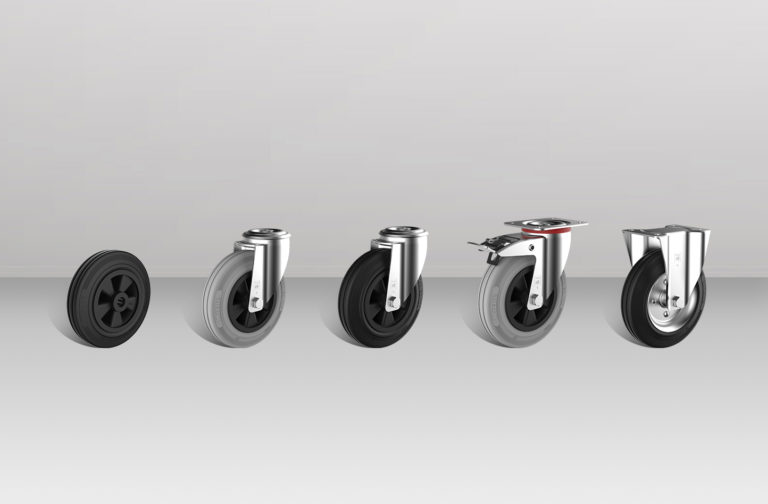Advanced Materials for Enhanced Performance
The basic trait of modern heavy-duty wheel design is a new modern material used. Now, instead of steel and rubber, polyurethane is used in combination with nylon and composite as either a substitute for or a complement to the old ones.
These ensure excellent quality, strength, and durability, and wear resistance even in situations supporting heavier loads. They also deliver good performance even in environments with adverse conditions.
Ergonomic Design for Optimal Maneuverability
Other major designs that have been improved in the heavy-duty caster wheels include emphasizing ergonomic design principles. The improved caster wheels are designed in a manner that increases smooth maneuverability while at the same time reducing the force and fatigue subjected to by the users of the caster wheels. Enhanced swindle mechanisms offer superior, quick movement with smooth and responsive behavior and improved ergonomic handles and grips that offer a safer, more ergonomic work area, resulting in improved productivity and ease of handling materials.
Precision Engineering for Seamless Mobility
These efficiencies have pushed the heavy-duty caster wheel manufacturers to adopt precision engineering techniques. In fact, very sophisticated manufacturing processes like CNC machining and injection molding bring out caster wheels with a tight tolerance and smoothness nearly that of bearings.
This brings in a lot of reduction in friction, whereby reducing rolling resistance and giving better control in movement, thus ensuring smooth mobility even in the toughest conditions.
Customization Options for Tailored Solutions
The caster wheels come in a different variety that is available in the market for customization according to the varied requirement of different industries and environments. Load capacities, wheel sizes, mounting configurations, and tread patterns—all of these are considered. The customers are thus in a position to describe their needs in a way that the caster wheels are easily fit in present equipment and ways of work, hence ensuring maximal efficiency and productivity.
Integration of Smart Technologies for Enhanced Performance Industry
4.0 spares no heavy-duty caster wheels; it sees the incorporation of state-of-the-art technologies such as IoT sensors and RFID tags on them. These will allow collecting, in real time, data on the weight of the loads, temperature, and speed, which together will lead to predictive maintenance and further support the optimization process of material handling.
Noise Reduction Technology
In environments where noise pollution is a concern, such as hospitals or offices, heavy-duty caster wheels equipped with noise reduction technology are gaining traction. These wheels incorporate specially designed components to dampen vibrations and reduce frictional noise, ensuring quieter operation without sacrificing performance.
Anti-Corrosion Coatings for Longevity
In industries where exposure to moisture, chemicals, or corrosive substances is prevalent, heavy-duty caster wheels with anti-corrosion coatings offer extended durability and longevity. These coatings, such as zinc plating or powder coating, create a protective barrier that shields the wheels from rust and corrosion, prolonging their service life even in the harshest environments.
Load-Sensing Systems for Optimal Performance
To optimize material handling processes and prevent overloading, some heavy-duty caster wheels now feature load-sensing systems. These systems utilize sensors embedded within the wheels to measure the weight of the load and adjust the wheel’s performance accordingly. By automatically distributing weight and adjusting traction, load-sensing caster wheels ensure optimal performance and prevent damage to equipment and materials.
Sustainability Initiatives in Material Selection
With growing emphasis on sustainability and environmental responsibility, caster wheel manufacturers are exploring eco-friendly materials and production processes. From recycled plastics to biodegradable composites, sustainable materials are being incorporated into heavy-duty caster wheel design to reduce carbon footprints and minimize environmental impact.
Multi-Directional Wheels for Versatility
In applications where maneuverability is critical, heavy-duty caster wheels with multi-directional capabilities are gaining popularity. These wheels, also known as omni-directional or mecanum wheels, feature a unique design that allows them to move in any direction without the need for steering adjustments. This versatility enables smoother navigation through tight spaces and around obstacles, enhancing overall efficiency and productivity.
Shock-Absorbing Technology for Enhanced Safety
In high-impact environments such as construction sites or manufacturing facilities, heavy-duty caster wheels equipped with shock-absorbing technology are essential for maintaining safety and stability. These wheels incorporate specialized mechanisms or materials that absorb and dissipate shocks and vibrations, reducing the risk of damage to equipment and ensuring a smooth, controlled ride over uneven surfaces.
Meeting Industry Demands: The Role of Caster Wheel Manufacturers in India
India is the home of heavy-duty caster wheels with a host of companies offering very specialized products. Leveraging such engineering talent and manufacturing capability, companies have been able to deliver a cutting edge solution across the globe.
These are considered contributing to driving the Indian manufacturers in innovation, along with cooperating with industrial partners and investing in new technologies by way of R&D.
Conclusion:
A New Era of Mobility Innovation is the lifeline to progress, particularly evident in the revolution of heavy-duty caster wheel design. Game changers in industrial mobility lead with advanced materials, engineering excellence, and precision manufacturing, in addition to ergonomic design principles—all supported by advanced customization using smart technologies. Which would provide great efficiency gains, performance improvements, and safety at best in some of the new levels in mobility and material handling across a wide range of industries.
